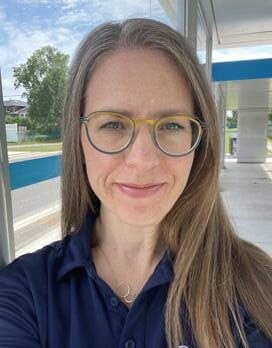A number of years ago, I started the practice of sitting in silence for several minutes at a time. I haven’t been very consistent. I’ve let distractions squeeze the discipline out of my mornings—distractions like the first several months of my dog’s life, the kids doing online school, summer holidays. But every once in a while, my life has just enough of a predictable time of solitude that I am able to reintroduce my silent minutes.
Sometimes in the silence, I focus on a word or a phrase to keep me centered, but most of the time I imagine myself in a clearing. Trees tower all around and I lie down on the grass. The grass is not itchy (this is important). It is soft and there are no tree roots digging into my back. It is warm and breezy and the sun dapples. Sometimes Jesus is there with me. Usually, I am alone.

(My daughter, Naomi, took this picture last year and I gasped when I saw it. “That’s it!” I said. “That’s the clearing in my mind.”)
And in that place, I breathe. I breathe in as deeply as I can. And as I breathe in, I look up, up, up past the tops of the trees to the patch of sky. I hold my breath there – not in a panicked way, like when my sister and I would have competitions to see who could hold their breath the longest or when I used to try to read an entire page of a book out loud without taking a breath. No, I hold my breath in a light and easy way – for just a little while – watching the breeze move the tops of the trees. And then I slowly let my breath out. As I do, my eyes travel down the trunks of the trees. When I reach the end of the breath, I hold there. I close my internal eyes and let a part of my body sink into the grass. I start with my feet. And then the cycle begins again. With each Empty-Breath Hold, I sink another part of my body into the grass. My calves and thighs and middle. My hands and arms. My chest and shoulders. My head. Sometimes I fall asleep. That’s okay. Now I lay me down to sleep. I pray the Lord my soul to keep.
After my mom was diagnosed with cancer, I added a dimension to my breathing. I started imagining my exhales as My Last Breath. Or Mom’s Last Breath. As my eyes traveled down the trees and as I sunk into the earth, I imagined death and burial and never breathing again. Lungs all out of air. I even let myself hold that empty-lungs-moment a bit too long to feel the sadness and desperation of it all. Sometimes I started crying. That was okay. If I should die before I wake, I pray the Lord my soul to take.
And then, as I filled my lungs back up with air, I imagined my inhale as My First Breath – my first breath out of the womb. Or Mom’s First Breath on the other side of death. The joy. The relief.
And then the cycle would begin again. Death. Life. Breathe Out. Breathe In. Burial. Resurrection. Sadness. Joy.
Not long ago, I heard someone say that physical death doesn’t happen on or at the end of the exhale. Death doesn’t happen at the bottom of your breath. Death happens at the top of the breath – after the inhale. Your last breath is an active inhale. The exhale is post-death – your body involuntarily letting go of the air you took in during your last breath.
I dug around to see if I could confirm the science of all of this. I read enough to satisfy my curiosity. It does make good sense.
And so I’m imagining something different now in my moments of silence. I imagine the Letting Go of death at the top of my breath. At the top of the trees. With the breeze. Close to the sky. Though I am sure there are final breaths that are desperate and panicked, in my practicing for my own death, I now imagine the Letting Go of death with my lungs graciously full of air.
It is the last day of 2021. If the last day of the year is like an older person, ready to breathe just one more time, let’s think of today not as an exhale, but as an inhale. Let’s live this last day of the year not as a lungs-emptying-desperate-for-air-exhale, but as a big breath in – lungs graciously full – our eyes traveling up to look around at the trees and the sun. Hold it there – lightly. Suspend and drift into the new year on the gift of God’s breath in you.
Now I lay me down to sleep,
I pray the Lord my soul to keep.
May angels watch me through the night,
and wake me with the morning light.
Header Image: Photo by Brett Jordan on Unsplash

